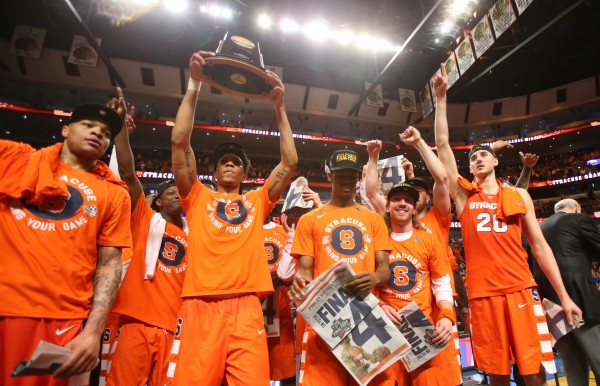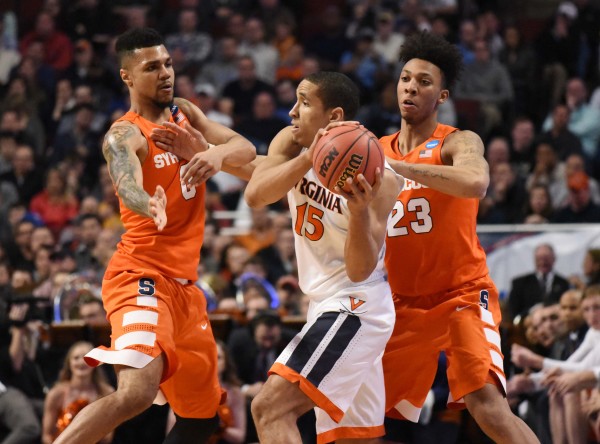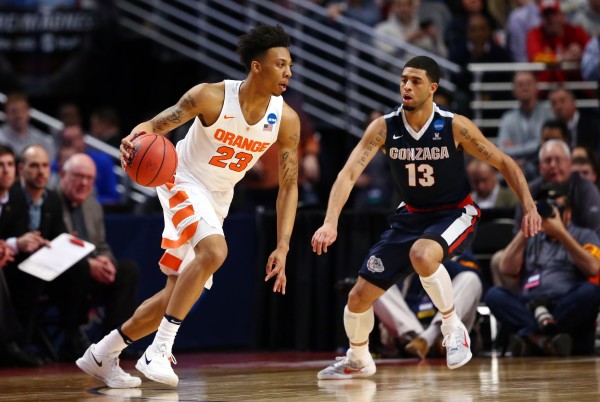Final Four Fact Sheet: Syracuse Orange
Posted by Bennet Hayes on March 29th, 2016Now that the Final Four is set, our writers have put together a fact sheet on each of the four teams still remaining. Finally, Syracuse.
How Syracuse Got Here

Syracuse unexpectedly conquered all foes in the Midwest Region. (Photo: Dennis Wierzbicki-USA TODAY Sports)
Midwest Region Champions. Syracuse took a ride through the Midwest region that few expected. The tenth-seeded Orange defeated Dayton in round one, then made the most of a fortunate second round draw by knocking off fifteenth-seeded, Spartan-slaying, Middle Tennessee State. Jim Boeheim’s team proceeded to find lightning in a bottle twice at the Chicago regional, overcoming a nine-point deficit with less than five minutes to play against Gonzaga before supplying the most shocking victory of this stunning Syracuse March run: a regional final victory over #1 Virginia in which they overcame a 15-point deficit with less than ten minutes to play.
The Coach
Jim Boeheim. No stranger to Final Fours (this will be his fifth), even Boeheim himself has to be surprised to be making the trip to Houston this week. No Syracuse team has ever entered the Tournament with a higher seed than this one, and an uninspiring regular season left little hint that a run like this was coming. Boeheim has always enjoyed a little disrespect from the media and he’s been masterful in using the “nobody believes we deserve to be here” narrative as fuel for this run. If he can use that rallying cry (or any other tactic) to grind out two more wins in Houston, this will undoubtedly go down as his greatest coaching job in a career full of them.
Style
Syracuse is 318th nationally in overall possessions per game, but their offense doesn’t move unusually slowly – their average of 17.6 seconds per offensive possession is only just below the national average. It’s the vaunted 2-3 zone that is grinding Syracuse games to a snail’s pace. Opponents use 19.2 seconds per possession – the longest defensive average in the entire country. This is emblematic of a particularly effective edition of the Syracuse zone, as the Orange ranks 16th in the country in overall defensive efficiency. The approach on the other end of the floor is definitively less organized, but the consistency of senior Michael Gbinije (17.6 PPG, 4.4 APG) has helped overcome the up-and-down play of his less reliable supporting cast. The Orange do shoot a lot of threes (42.4 percent of their field goal attempts have come from beyond the arc), but are also active on the offensive glass, grabbing over a third of their missed field goal attempts on the season.
Strengths

Virginia is not the first opponent that Michael Gbinije, Malachi Richardson and the Syracuse 2-3 zone have locked up. (Photo: David Banks-USA TODAY Sports)
- Halfcourt defense. We mentioned how good the 2-3 zone has been all season, but its disruptiveness has only reached new heights in this Tournament. No Syracuse postseason opponent has managed better than .97 points per possession, and the top 25 offenses of Gonzaga and Virginia were rendered particularly passive: the Zags and Cavaliers combined to shoot just 17 total free throws while turning the ball over 30 times. The zone is Syracuse’s greatest weapon, bar none.
- Variety in offensive weapons. Syracuse has a number of players capable of having a big game offensively, so it can be hard to game-plan for the Orange. Gbinije has been the reliable force, but Malachi Richardson, Tyler Lydon, Trevor Cooney, and Tyler Roberson have all taken turns in starring roles this season. For better or worse, it’s impossible to know which of these guys will step up with a big game on the offensive end.
- Mindset. Part of the credit for the Orange’s diligent approach to this Tournament should go to Boeheim, who is probably underrated as a motivator. More of it should go to the simple fact that they are a #10 seed that nobody expected anything from. Syracuse hasn’t cared what the media or fans have said or thought for quite awhile; maintaining that disinterest may come in handy against a North Carolina team with plenty of pressure on them to handle business on Saturday.
Weaknesses
- Interior defense. It’s no shock, but opponents must find success within the arc to beat the Syracuse zone. One way to do this is to find touches for big men in and around the paint – Syracuse has allowed opponents to shoot over 47 percent on two-point field goals (just 110th best nationally). The other is a tried-and-true method for destroying almost any zone: offensive rebounding. Syracuse is 337th nationally (out of 351 teams) in defensive rebounding percentage. This will be especially problematic against UNC, the third-best offensive rebounding team (by percentage) in the country. In their last meeting on Feb. 29, the Tar Heels grabbed nearly as many offensive rebounds (19) as Syracuse did defensive rebounds (22).
- Depth. The Orange’s seven-man rotation hasn’t been subject to injury or foul trouble in this Tournament, but Syracuse’s lack of depth looms as a potential obstacle to advancement. On the season, SU is 350th nationally (out of 351) in bench minutes percentage (per KenPom); against Virginia, four starters and Lydon all logged at least 32 minutes. With nearly a week of turnaround time before Saturday, fatigue shouldn’t be an issue, but foul trouble or ineffective play from almost any rotation player could prove crippling for this thin Orange team.
- Experience. One could easily make the argument that, to this point, Syracuse’s lack of experience may have aided its brash jaunt through the first four rounds of this Tournament. How was this team the first #10 seed to make the Final Four? Perhaps they just didn’t know better. With increased attention in Houston, however, expect the lack of Tournament experience to begin mattering. Before this season, the only Syracuse player on the roster who had started a Tournament game was Trevor Cooney (and just two, in 2014 against Western Michigan and Dayton).
Go-To Scorer
Michael Gbinije (17.6 PPG, 4.4 APG). Jim Boeheim called his senior point guard “the most underrated player he’s ever coached.” Taking Boeheim at face value can be a dangerous proposition, but there’s little doubt Gbinije has often been overlooked this season. The second-team All-ACC player has transformed into a do-it all point guard capable of setting up teammates (4.4 APG), rebounding his position (4.1 RPG) and causing havoc at the top of the Syracuse zone (2.0 SPG). There wouldn’t be a weakness in his game if he shot the ball better from the free throw line (66%), because he’s been one of the most efficient field goal shooters in the ACC all season. Gbinije has made 53 percent of his attempts inside the arc and 40 percent of his efforts from beyond it.
X-Factor

Malachi Richardson has not put together the most consistent freshman season, but has the talent to take over games. (Photo: Dennis Wierzbicki-USA TODAY Sports)
Malachi Richardson (13.3 PPG, 4.3 RPG). Richardson has been wildly inconsistent this season. However, when he’s on (see: Sunday’s second half vs. Virginia) the freshman is fully capable of taking over a game. His season-long shooting percentages won’t impress (38% from two-point range and 35% from beyond the arc), but Richardson’s confidence should be high after a dynamic second half performance in the regional final. Jim Boeheim mentioned that Richardson has been a great second-half player all season long; for the ‘Cuse to advance, Richardson might need to be a great first and second half player Saturday.
Outlook
Syracuse has been playing with house money for two weeks now, and they’ll have more of it in their pockets when they take on the new Tournament favorites on Saturday. Beating North Carolina will almost surely necessitate shooting a better percentage from long range than the 27 percent (14-51) they shot in the two regular season matchups with the Tar Heels. Gbinije, Cooney and Richardson aren’t necessarily the most prolific trio of perimeter shooters, but all are capable of getting hot on any given night. A couple of them will need to on Saturday, as the Orange zone is unlikely to keep UNC’s long, talented front line off the offensive glass for long stretches. The more likely scenario, however, is that not enough shots fall to keep pace with a Carolina team well-constructed for overwhelming the zone. That development would likely end this blessed March run on April’s second day.











































